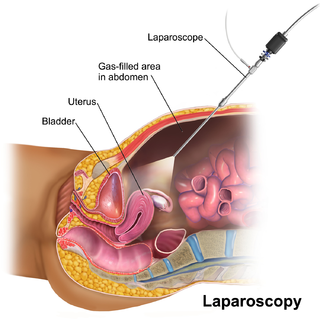
Surgery is a medical specialty that uses manual and instrumental techniques to diagnose or treat pathological conditions, to alter bodily functions, to reconstruct or alter aesthetics and appearance, or to remove unwanted tissues or foreign bodies.

Laparoscopy is an operation performed in the abdomen or pelvis using small incisions with the aid of a camera. The laparoscope aids diagnosis or therapeutic interventions with a few small cuts in the abdomen.

Arthroscopy is a minimally invasive surgical procedure on a joint in which an examination and sometimes treatment of damage is performed using an arthroscope, an endoscope that is inserted into the joint through a small incision. Arthroscopic procedures can be performed during ACL reconstruction.

A textbook is a book containing a comprehensive compilation of content in a branch of study with the intention of explaining it. Textbooks are produced to meet the needs of educators, usually at educational institutions, but also of learners. Schoolbooks are textbooks and other books used in schools. Today, many textbooks are published in both print and digital formats.

Orthopedic surgery or orthopedics is the branch of surgery concerned with conditions involving the musculoskeletal system. Orthopedic surgeons use both surgical and nonsurgical means to treat musculoskeletal trauma, spine diseases, sports injuries, degenerative diseases, infections, tumors, and congenital disorders.

The New York University College of Dentistry is the dentistry school of New York University. As the third oldest dentistry school in the United States, it offers both graduate programs and clinical training in oral healthcare.
Deutschsprachige Mykologische Gesellschaft (DMykG) e.V. has been acknowledged as a non-profit organisation. The society was founded in 1961 as a platform for all scientists of the German-speaking area who are interested in mycology either from a medical or veterinary standpoint, i.e. medical mycology or veterinary mycology. To promote science and research is a prime concern. The society is based in the city of Essen.
Timothy James Herbert is an orthopaedic surgeon specializing in hand surgery. He was born in Sheffield (UK). He is known for his work with the scaphoid bone and related invention, the Herbert screw.

Radial tunnel syndrome (RTS) is a compression neuropathy of the radial nerve as it travels from the upper arm to the hand and wrist.

The cervical spinal nerve 6 (C6) is a spinal nerve of the cervical segment.

The German Network for Evidence based Medicine is a scientific nonprofit association of individuals and institutions promoting the quality of patient care and disease prevention by applying the principles of evidence-based healthcare (EbHC) - in special dentistry (EbD), medicine (EbM), nursing (EbN), pharmacy, physiotherapy - in the countries of German language.

The Association of the Scientific Medical Societies in Germany, established in 1962 and located in Frankfurt am Main, is the umbrella organisation of more than 150 German medical societies.
An open textbook is a textbook licensed under an open license, and made available online to be freely used by students, teachers and members of the public. Many open textbooks are distributed in either print, e-book, or audio formats that may be downloaded or purchased at little or no cost.

David Coston Sabiston Jr., M.D.,, F.A.C.S. was an early innovator in cardiac surgery. In 1962, he performed a seminal procedure that paved the way for modern coronary-bypass surgery, grafting a vein from a patient's leg to bypass a blocked coronary artery during open-heart surgery. The patient died from unrelated complications, but Sabiston's technique and other surgeons' improvements on it led to the development of surgical coronary revascularization as it exists today.

German National Library of Medicine, abbreviated ZB MED – Information Centre for Life Sciences in Cologne, together with the Bonn site, is the central specialist library for medicine, public health, nutrition, environmental and agricultural sciences in Germany. The focus is on collection development, full text supply and projects in the field of information sciences. ZB MED provides science, research, students and other interested parties with specialist literature and information. It is financed by the Federal Government and Federal State of North Rhine-Westphalia.

The Deutsche Dermatologische Gesellschaft e.V. is a scientific specialized society for dermatology in Germany. It is a member of the Association of Scientific Medical Societies in Germany (AWMF).

Pradeep Kumar Chowbey is an Indian surgeon, known for laparoscopic and bariatric surgeries. He is the incumbent Executive vice chairman of the Max Healthcare, Chairman of the Minimal Access, Metabolic & Bariatric Surgery and Allied Surgical Specialities of the Max Healthcare Institute, New Delhi. He is the founder of the Minimal Access, Metabolic & Bariatric Surgery Centre at the Sir Ganga Ram Hospital, New Delhi and has served as the Honorary Surgeon to the President of India, Dalai Lama and the Indian Armed Forces (AFMS). The Government of India awarded him the fourth highest civilian honour of the Padma Shri in 2002.
Jeffrey Evan Budoff is an American orthopedic surgeon. Budoff has written and published 41 articles on health topics and has authored 20 textbook chapters. He has edited five textbooks on the treatment of disorders of the upper extremity.
Björn Dirk Krapohl is a German surgeon, specializing in plastic surgery and hand surgery at the University of Lübeck and the Charité in Berlin. He is known for his work in the fields of reconstructive microsurgery, hand surgery, and breast surgery.

Rolf Kreienberg was a German gynaecologist and obstetrician.














